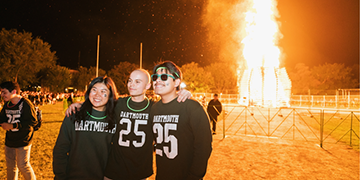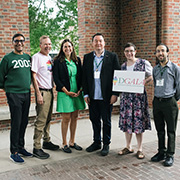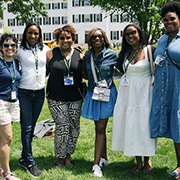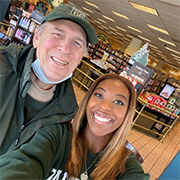50 for 50 Podcast: Selassie Atadika ’98
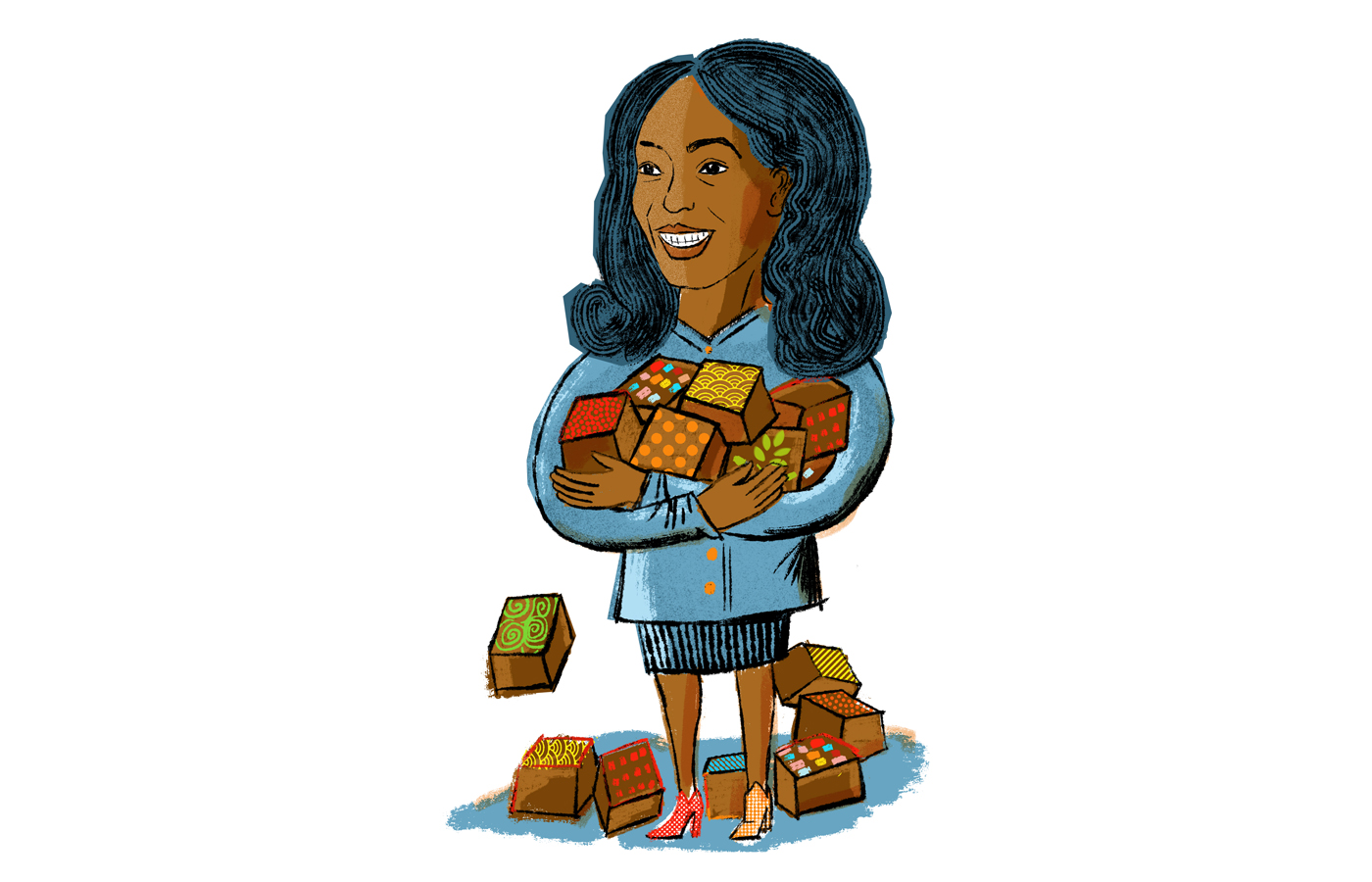
Jul 27, 2022
20 minute read
20 minute read
Selassie Atadika ’98
Selassie Atadika ’98 has two lifelong passions: world travel and food.
She honed in on those passions at Dartmouth, majoring in geography modified with environmental studies—while always maintaining her lifelong love of food. After graduation, she became a globe-trotting, internationally acclaimed chef renowned for her plant-based African recipes. And spending a decade working for the United Nations, she became what she calls a "food ambassador."
A founding member of Trio Toque, the first nomadic restaurant in Dakar, Senegal, Selassie went on to launch Midunu (which means, in Ewe, "let's eat”), a nomadic dining concept featuring what she calls New African Cuisine. When Covid temporarily closed the restaurant doors, she launched an offshoot, Midunu Chocolates. For Atadika, sustainably grown foods packed with bold flavors and exotic spices tells the story of an entire continent.
Selassie's Website
Midunu Chocolates
Midunu Institute
Dartmouth Alumni Magazine Feature
Transcript
Jennifer Avellino:
Hi, everyone, and welcome to our 50 for 50 podcast, 50 stories for 50 years, as we celebrate three major milestones in Dartmouth's history. As many of you know, and some of you can remember firsthand, 1972 was a pivotal year. Women joined the undergraduate community as Dartmouth students, following several years of women exchange students on campus. The Black Alumni of Dartmouth Association, or BADA, is also entering its 50th year. And so is the Native American program. Quite the trifecta of anniversaries, and also not a coincidence that so much happened during this critical time. I'm Jennifer Avellino, class of 1989, past president of the Dartmouth Alumni Council and a former senior producer at CNN. As a journalist, my early days were spent as the news director for WDCR, WFRD, Dartmouth Broadcasting. I've had the good fortune to meet and bring to the airwaves remarkable people over the years, and this podcast, in many ways, brings me home.
Over the next few months, I'll be talking to inspiring, influential, and fascinating Dartmouth alumni. They'll reflect on what it was like to be a woman, a native American, a person of color at Dartmouth, and how their time at the college led to the lives they're pursuing today. Our guest today is chef Selassie Atadika, class of 1998. The founder of Midunu in Accra, Ghana, a pioneering food business and lifestyle company that features nomadic dining. She has a master's in international affairs from Columbia University, and at Dartmouth was a geography major modified with environmental studies. She spent a decade working for the United Nations around the world, then studied at the Culinary Institute of America. She now lives in Ghana where she celebrates African culinary heritage through new African cuisines. Selassie, welcome.
Selassie Atadika:
Hi, how are you?
Jennifer Avellino:
Great to have you with us.
Selassie Atadika:
Thank you.
Jennifer Avellino:
So you left Ghana with your family when you were about six years old, and you grew up in New York. How did you end up at Dartmouth? Tell us about how you spent your time in Hanover.
Selassie Atadika:
Yeah. When I was getting ready for college, I had a rule of a four-hour distance from home, so Dartmouth was one of the perfect ones. I loved the small campus. I wanted to be in a place where I didn't feel overwhelmed by the other students. And I actually love nature, and today, I love nature. So it was a perfect match for me.
Jennifer Avellino:
Tell me more about how you spent your time as a student.
Selassie Atadika:
Let's see, I started off pre-med and I ended up doing environmental studies and geography. I joined Sheba, which was a dance group that was just starting out at the time, and that was probably how I spent most of my time when I wasn't doing schoolwork. I also loved cooking and spent a lot of time just baking for friends and for myself, throwing dinner parties when I moved off campus.
Jennifer Avellino:
So there were glimmers of your world to come.
Selassie Atadika:
Absolutely.
Jennifer Avellino:
But a career in food was not what you pursued when you graduated.
Selassie Atadika:
No.
Jennifer Avellino:
What did you do for the UN and UNICEF and what appealed to you about humanitarian development work?
Selassie Atadika:
So I started working with the UN pretty early on. I interned, and it took me a little while to find my legs. Initially, I was planning to do Peace Corps and then that didn't work out, I don't remember all the details at this moment. But the next best thing at the time I felt was to continue the idea of trying to support people in need. And at that time I translated that to mean working at the UN, so I interned in New York for UNIFEM, which is, I guess, UN Women now, doing support to projects and programs that were looking for women's empowerment. From there, I actually started working with the UN peacekeeping and my first stint abroad for the UN was working in Kosovo. That was about three months after the NATO bombing in 1999. And from there, I guess, I caught the bug and started working for the UN in post conflict situations.
Jennifer Avellino:
What were some of the most important things you learned about the world, about yourself during this time?
Selassie Atadika:
I think one of the core lessons was having a sense of home while you're traveling. A lot of that I think had been instilled in me in the U.S. with the way we held onto food as our cultural magnet. So as we were growing up in New York, food was really one of the ways we held onto our Ghanaian culture. And as I traveled, I realized that food was still very important to me, and there are moments where we were getting ready for evacuations and I have bits of food or things that I would eat at home that would make me feel comfortable. I also realized that you needed to create community wherever you are, and find the people that you can relate to that have your back, but also understand you, and building community in different spaces and places. So those are probably two of the biggest ones that I got to focus on while I was doing the work that I was doing.
Jennifer Avellino:
Yeah. Certainly, a way to bring people together.
Selassie Atadika:
Yeah.
Jennifer Avellino:
I read that you said you cooked and ate your way through Liberia, South Sudan, Kenya, and Senegal during your time at the UN. You've been to more than 40 countries in Africa?
Selassie Atadika:
Yeah.
Jennifer Avellino:
Yeah. Why did you finally decide to go to culinary school?
Selassie Atadika:
I think there's probably a couple ways of answering that, but one of the first was, culinary school was just a way for me to codify what I knew and to get an alphabet that could speak to the rest of the world. So as I was traveling around, I realized that in some situations, food was something that would bring people together, so when you would see people that were displaced, they would share whatever they had, and those were the moments that people would stop whatever they were doing and then just come together. I also got to see food being a possible way to bring back economies in countries that had fallen apart and were trying to come back together. So in terms of, for example, seeing the beginnings of an economy, being able to grow food, sell food, feed people, were the ways that community came together.
And, I think, my biggest aha moment was doing work on malnutrition in the Sahel, a few years before I actually decided to leave full time the UN. But one of the things that I got to see which, I think, for me was a very pivotal moment was during my time working and spending a few weeks in northern Nigeria, where we were doing a response to malnutrition. One of the products that we use, which is actually a therapeutic food it's medicine, it's, I think to the layman, we could call it like a peanut butter that's been fortified with micronutrients and what's required to save a child's life. So this box of product called Plumpy'nut has about 30 packs in it. Each pack is for a day, one pack a day for 30 days can save a child's life. And we were trying to make sure that the supplies were arriving on time and to make sure there were no stockouts in the health system there.
And I looked around me and I was thinking to myself, this product is coming from France, it's coming through the ports, it's made with peanut butter, which doesn't grow in France, but does grow where I was. And just made me realize how broken the food system was and how solutions are actually very much around us, but we need to really look at some of the challenges that we're having in our food system and trying to better understand it. The problem is not as simple as there's not food available, but rather what does the food system look like? What are the challenges? Why are people eating or not eating? What is the issues around access? What are the politics at play in what we grow and where we grow and who's controlling it? And that's when I really realized that there's more than one way to solve a lot of these problems, and in community we can do more.
I went to the culinary school to be able to speak to the gastronomic world—to be able to cook better, to be able to understand how to express what I was feeling and tasting. In my travels, I also realized there was a lot of misconceptions about African cuisines. A lot of people thought either we didn't have food, because in their mind they're still seeing children in these videos from the early '80s, they're seeing food aid going into Africa and not fully understanding how complex the food systems are globally and what the situation was. And so I kept getting a lot of people saying, hey, I really don't know about this African cuisines or I've been in Liberia and I've not tasted anything great or it's only chili. And so, I guess, I like a good challenge. And so I decided that it was something that I could address from all the amazing things I'd been eating throughout the continent. I wanted to also be part of a group of people who could speak to some of the complexities that were on the ground.
I know when I went in as pre-med, my parents were quite excited, and my dad is still like, "You were supposed to be a doctor." But I do feel that the long and winding road, each and every step and every component has led to my understanding and the way in which I feel I can advocate for food and for African cuisines and for food being something that can actually stimulate economies. So yeah, environmental studies, geography, and a little bit of an early background in the sciences has really been helpful to me to be able to piece what I do together.
Jennifer Avellino:
Do you draw that line back to your geography major and your environmental studies?
Selassie Atadika:
Absolutely. I would say, particularly, when I started working on what I call my cuisine—I call it New African cuisine—for me, it's where culture, community, and cuisine intersect with environment sustainability and economy. So one of my very first lessons, it was actually an elective, while I was premed I took an elective in geography and the class was about how people gain power through space and place, and it was really focused on human geography. So when I think about what I do now, when you start talking about food and cuisine, the basis of it is what grows where you are. So when you look at community, community started because we were able to have agriculture, we went from hunters and gatherers to settled people because of agriculture. Then when you take what grows where you are, you start to realize how a cuisine is developed.
Then when you think about preservation techniques, because we didn't have refrigeration, you start thinking about all these methods of preservation that have become the fabric of a cuisine and on and on. So for me, I always go back to what grows here and what does well here. And as I've been thinking about that, particularly, as we're looking at climate change, you start seeing what grows in Northern Ghana? How do we make that sexy and exciting for people to want to eat? And how do we get that on a plate in a way that's delicious and it's going to make people excited. And that's how you start forming the new cuisine that we need to start thinking about for the next few generations.
Jennifer Avellino:
So it really sounds like both your Dartmouth studies and your development work provided the foundation for everything that you're doing now. Tell me about some of the food that you grew up eating and the role that, that plays in the recipes and the dishes that you develop now for Midunu, and what does Midunu mean, by the way?
Selassie Atadika:
Midunu comes from the Ewe language, which you would see in the Eastern part of Ghana and the Western part of Togo. It's short actually for va midunu; va midunu means come let's eat. And so I settled on that for a couple of reasons, the first being that growing up in Westchester, whenever my father would come home for work, the first thing he would say when it was time to eat is va midunu. So it was always a call for the family to gather around the table for dinner. I don't speak a lot of Ewe but that's one of the ones that I know very well. And for me, it just brings me back to home, it brings me back to a sense of place. The other part of why I settled on Midunu is the democracy of it all.
Culturally, we always invite people to eat, you never eat alone. So I've had a lot of my UN international colleagues who've been based in Africa give me feedback about some of the awkward situations they've gotten into, because, let's say, they were having lunch at a desk and they didn't invite anybody. So, we really do invite people whenever we sit down to eat, it's something that we're blessed to have and we share that with others. And then the last part was just really, how do we think more about getting more people to eat and eat better and eat well? I do think that when I design my dishes, when I think about what I'm doing and the advocacy work that I want to be involved in, it's not necessarily for eating today, it's really about what should we be eating in 2050? What should we be thinking about? What should we be growing to enable us to do that? And that's my genius space and that's where I love thinking and creating around and working on.
Jennifer Avellino:
This is about so much more than the food itself. But before we talk more about that, give us a little bit of the flavor of the food itself and what you've been cooking with lately. If you were making us dinner tonight and wanted us to experience some of your favorite recipes lately, what would you be cooking with? What's on the menu?
Selassie Atadika:
Yeah. So I would say that for Ghana, relative to maybe some other places, I would characterize our cuisine as bold, flavorful. We use a lot of tubers in a lot of our traditional food, be it yam, cassava, sweet potato, we have a lot of ancient grains that come from millet, sorghum, fonio, which I think, is coming up in the U.S., now you can find it in many different outlets. We have a lot of preserved ingredients, so if you can imagine being so close to the equator, the temperature is warm, so traditionally we've done a lot of salting and smoking and drying of fish, meat, and other ingredients. We also have our own sense of fermentation that's been built up throughout the years. And so these flavors form the foundation of our cuisine. Very specifically, I know a lot of people probably would've heard about jolloff rice, which is a west African dish now, which would be using rice, the closest way I can describe it is like a paella, maybe.
So it's a tomato-based sauce or stew that's made, and then we add rice to it, the rice absorbs all that flavor and is cooked into it. It's a West African dish, I say, because it actually comes, originally, from Senegambia region. But every country, region has their own version of it. We have starches that are parts of meals that include foofoo, which is pounded plantain and cassava, we've got something like kenkey, which is a cornmeal that's been fermented for several days and then cooked either in banana leaf or in corn husk, almost wrapped similar to what you would expect from like a tamale. When you look at a lot of other cultures, not just Ghanaian or not just African, you realize that we found ways to make food last and to have sustainability built in these food systems.
So we didn't eat meat very often because you eat meat when you have a special occasion. And so, you will see that a strong part of our cooking and food culture is using beans, seeds, nuts, such as groundnuts, bambara beans, black eye peas, and all of these being dishes that we would have that have enough protein and carbohydrates that you would need. One of my favorite dishes is, just like a street food, it's a snack, it's roasted plantain and roasted peanuts. And so it's something that you will find on the street side, almost anywhere in Accra during the right season. But locally, it's just, the slang for it as Kofi Brokeman. Kofi being one of the day names in Ghana and that Kofi Brokeman being no matter what your budget is, no matter what you've got, you can actually afford this.
But when you look at the snack, you've got carbohydrates from the plantain, you've got fat and protein coming from the groundnuts, and they actually fill you up. I was in town and my car broke down a few years ago, and I stopped, I called my mechanic, I was waiting for him to come, and I was hungry. So I ventured across the street, there was a woman who had the plantain and peanuts. And I got some and I sat in my car and was waiting for the mechanic. And as I was eating the snack, I just decided to make a dish out of it. So I actually did create a dish from it, I call it Kofi Richman, because Kofi is no longer broke. Kofi Richman is a dish that uses textures of plantain and peanuts, so I have two or three different ways in which the plantain appears. One is using plantain in its unripe form, green plantain, then chips with it, which is the way most people would eat it. Like a bar snack, but now we're adding it and giving it value.
I've used the plantain in its overripe form, so most people might have thought about throwing away that plantain, but we don't, we want to just make sure we maximize it. So there's a dish that I learned about when I was living in Liberia, it's called Liberian rice bread, so it's taking over ripe black, basically, plantain or bananas, using ground rice and making that into a cake. We have a snack in Ghana called adaakoa or dzowey; it's peanuts that have been pounded with ginger, roasted corn flour, a little bit of sugar, and it's usually rolled into a ball almost the way you would have like a power bar or a snack, and we've turned it into a mousse.
So that dish brings in different stories of culture and heritage, different conversations about ripe versus unripe versus how do we waste less? It also brings in conversations about class, because I think in many ways we think of it as a snack you eat when you're poor, but now I'm bringing it to a different space and place for it to be enjoyed. So those are all the different layers that come into creating this dish, peanuts being something that also are nitrogen fixing for the soil, plantain being something that sequesters carbon. So it looks at the environmental impact as well.
Jennifer Avellino:
So you're known for focusing on plant-based food, you've been called one of the world's most innovative chefs when it comes to elevating vegetables, your recipes are varied, but plant focused.
Selassie Atadika:
Yeah. I tend to call it like plant-forward, if you will, the animal protein is a bit of more of a garnish. I think when I look at the way that we've preserved food, so even if I'm doing like a bean stew or bean castle or something like that, we have smoked fish and then that's a flavor enhancer. And it can really change things. For me, it's really about understanding the balance in how we cook, but also being able to make something delicious as well. I think that we do need a little bit of everything, I think that it's important to also know the diversity which we have. If we step away, maybe, from Ghana for a moment, and I'll even say, Ethiopia, there's an amazing cuisine that comes through their religious beliefs and they have fasting days. And so I think they have well over 100 fasting days in the year, and so because of that, you see this amazing vegetarian cuisine.
So you would find the beans being used, you find the beautiful flavors that have been built into these dishes. And I remember my first trip to India and I was traveling with a friend of mine who was vegetarian, and so I said, okay, let's... We spent a lot of time together during this workshop. And every evening after we finished, we'd go for a stroll, and then we would find ourselves in a restaurant. And I was like, I'm going to honor your way of eating as well, so we ate only vegetarian. But it was just like, being vegetarian is not a salad. There's a lot of beautiful flavorful food, and I think in the conversation that we're having now around plant forward, plant-based vegan, et cetera, there's a huge body of knowledge. So I can't even say what I'm doing is new, it's actually just being able to understand what we've done in the past and bring it forward in a way that makes sense for today. So let's not throw away what's happened before, but let's find a way to embrace it and enhance it.
Jennifer Avellino:
So whether we're speaking about India or Ghana or other countries in Africa that you're so familiar with, food that is traditional and authentic is not always what is locally grown or what is sustainable. How do you balance that?
Selassie Atadika:
I think the first level is understanding where your food comes from, and understanding the dynamics around those ingredients and those foods, and looking at issues around equity, issues around sustainability, issues around even preservation. Because, I think there's some things that we want to think about. Actually, me buying this helps to keep that culture alive, it's not an easy fix, it's not black or white, I think there needs to be a solid understanding of why you do what you do. And I think it's the intentionality at which we approach things is where we need to be thinking. And sometimes I have a challenge using the word authentic because food is so dynamic and food culture is so dynamic, I would really just say that we really need to consider all the various factors at play and keep our minds open.
What I do with the chocolates, I produce them in Ghana and I ship them to the US. But I do believe when you're making a purchase, it's important to also know what it means to buy from a cocoa- producing country, and what systems that supports and what narrative that supports. How do we give more money to producing countries? How do we start to fix some of the structural injustice in the food system? And I think that's where some of the thought needs to be. I would also say even being in the United States, there's a massive food culture that we have ignored for so many years. And we think about native American cuisine, how do we support that? But also how do you keep from exploiting that? I think there's a new trend towards west African ingredients, but one of the things that scares me about what I do is in many ways, I'm sharing what has been kept quiet for a long time. And if it's taken by the wrong people, it can actually cause exploitation.
We need to find ways in which to protect the communities and the cultures, and sometimes that means buying, but it means buying from someone from that community, that money going back to that community, sometimes it's better to buy local. I mean, it is a balance, maybe, it's more of an art than a science.
Jennifer Avellino:
Well, cultural appropriation of food is certainly a significant subject in many different cuisines. Currently, there are very few African restaurants in the United States. It'll be interesting to see how that evolves as we move forward. You mentioned your chocolates, tell me more about the chocolates produced by your company, Ghana is one of the world's largest producers of cacao. What are some of the different plants and spices that you're using and how are you telling the African story through chocolate?
Selassie Atadika:
Yeah, so the chocolates were a happy accident, and also, once again, a challenge that I decided to take on. I started offering these truffles at the end of the meal, and I said, okay, I'm going to start working on this chocolate thing, I'm going to share it with people at the end of the meal. And I started doing that and people started asking for them outside of the dinner. And I just felt like marrying something that people love and something that they don't know was a great space for the beginning of a conversation. We started off trying to bring in flavors from the different parts of the continent. So from West Africa, you'll find spices like prekese; prekese is one of the ingredients that's on the arc of taste list for slow food. So it means it's an ingredient that's at risk of being lost due to deforestation due to illegal mining, that ingredient is actually a pod.
It looks a little bit like a brown pod, it's got amazing nutty caramel notes, which really sing in chocolate. We have a tree basal from west Africa that's called sense leaf in English. Locally, we call it no num-num, it's a medicinal plant as well. We're using dawadawa, which in Nigeria, they call it iru, it is a fermented locus bean. For Southern Africa we are using Rooibos tea, we're using Cape Malay curry for Ethiopia. Eritrea we're using berbere spices. So you'll see that there are a lot of practices that are happening throughout the continent, and I try to bring them into the chocolates as well. So we have one that's flavored with mint green tea that you would find in the Maghreb, whether it's Morocco, Mauritania, maybe Senegal. And while I was living in Senegal, there is this practice of offering ataya, which is the tea.
So the first cup is always really sweet, and they say that represents birth. The second cup that they offer you is a little bit more intense because it's been boiling a bit longer, and that represents life. There's some sweetness, but there's also some bitterness to it. And the third cup they give you is the one that's fully bold and strong, and it's got a lot of green tea in there and a lot less sweet, and that represents death. The wonderful thing is being able to share this story about how I was sitting in this house and had finished eating my chebuchen and the third glass has come out and I'm sitting there and they're like, it's time to go.
And so I soon learned that the third cup is time to go. But also if they're enjoying your company, there's a long distance between the first and the second, and then the second and the third cup. So it's just wonderful little moments that I've experienced and I just find ways to share them with others. I feel really published to have been able to travel to all these countries and to have been invited into these homes. And I love being able to share the stories of the people that I've met, and the people that bring our food together.
Jennifer Avellino:
So you spend time thinking about how Ghana can feed itself in the decades ahead, especially, in a changing climate, but you're really focusing, it seems to me, on the preservation of culinary heritage, you're a culinary ambassador of sorts. Tell us about the legacy that you hope to leave.
Selassie Atadika:
I'm just really excited to work towards finding ways in which we can really preserve what is there. I'm currently launching my institute, which is looking at documentation, how do we document some of these ingredients? Or how do we document some of these "wives' tales" that are out there about, you eat this and this happens? A lot of them are very much founded in reality and the truths of indigenous knowledge, and so that's something that I want to actually write down and not just write it down, actually explore them and see what's happening. I'm also looking to create a space for exchange. I've learned from all these amazing women all around the continent, and I want to be able to allow more people to do that. So we're doing a culinary residency within the institute, bringing in young cooks from the US in culinary school to meet young cooks in Ghana to also meet aunties and grandmothers from the various villages and communities in Ghana.
We are also creating an opportunity for culinary journeys in August; it's going to be the first one, we're going to have whoever is interested and excited about it to come to Ghana, spend a couple of days with me to see the food system, to understand it. And also hopefully just creating networks where we can all support each other in the work that we're doing and trying to preserve the food system.
Jennifer Avellino:
Well, Selassie, it's been fascinating to speak with you about the food and the culinary heritage that inspires you and how you share that with others. Thanks so much for joining us.
Selassie Atadika:
Thank you so much for the time to share my story.
Jennifer Avellino:
It's been such a pleasure. And thanks to all of you for listening to our 50 for 50 podcast series supported by our office of alumni relations. I'm Jennifer Avellino, my thanks to our co-producers, Catherine Darragh and Charlotte Albright, and to Dartmouth's Media Production Group for technical assistance. We hope you'll join us for our next episode, marking Dartmouth's three milestone anniversaries. You can find out more about our 50 for 50 anniversary stories at alumni.dartmouth.edu.


